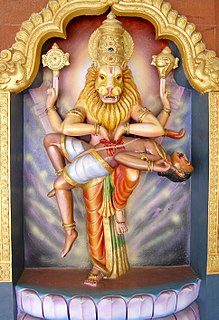
Back ناراسيمها Arabic নৰসিংহ (হিন্দু ধৰ্ম) Assamese Narasimha Awatara BAN Narasimha BCL নৃসিংহ Bengali/Bangla Narasimha Breton Narasimha CDO Narasimha German Ναρασίμχα Greek Narasinja Spanish
| Narasimha | |
|---|---|
| Member of Dashavatara | |
 | |
| Devanagari | नरसिंह |
| Sanskrit transliteration | Narasimha |
| Affiliation | Vaishnavism Avatar of Vishnu, Dashavatara |
| Abode | Vaikuntha, Kshira Sagara |
| Weapon | Sudarshana Chakra, Kaumodaki, Nails |
| Mount | Garuda |
| Festivals | Narasimha Jayanti, Holi |
| Consort | Lakshmi[1] |
| Dashavatara Sequence | |
|---|---|
| Predecessor | Varaha |
| Successor | Vamana |
| Part of a series on |
| Vaishnavism |
|---|
 |
Narasimha (Sanskrit: नरसिंह, lit. 'man-lion', IAST: Narasiṃha), is the fourth avatara of the Hindu god Vishnu in the Satya Yuga.[2] He incarnated as a part-lion, part-man and killed Hiranyakashipu, ended religious persecution and calamity on earth, and restored dharma.[3][4] Narasimha has three eyes, and is in the God of Destruction in Vaishnavism; he who destroys the entire universe at destruction (Pralaya). Hence, he is known as Kala (time), Mahakala (great-time), or Parakala (beyond time) in his names. There exists a matha (monastery) dedicated to him by the name of Parakala Matha at Mysuru in the Sri Vaishnava tradition.[5] Narasimha is the God of Yoga, as Yoga-Narasimha.[6][7]
Narasimha has a human torso and lower body, with a lion face and claws, with the asura Hiranyakashipu being disemboweled and killed by him in his lap. The asura was the powerful elder brother of the evil powerful Hiranyaksha, who had been previously killed by Vishnu as Varaha, and thus hated the latter.[8] Hiranyakashipu gained a boon from Brahma due to which he could not be killed during the day or night, inside or outside the house; neither in the sky nor on land nor in Svarga nor in Patala, by any weapon or hand, nor by humans, deities, demons, or animals.[9] Endowed with this boon, he began to wreak chaos and havoc, persecuting all the devotees of Vishnu, including his own son Prahlada.[3][9][10] Vishnu, cognisant of the asura's boon, creatively assumed a mixed form that was neither human nor animal as a lion in the name of Narasimha, and Narashima disemboweled and killed Hiranyakashipu and at evening, which is neither day nor night, at the threshold of his palace, which was neither inside nor outside, upon his lap, which is neither sky nor land, and with his claws, which are neither weapons nor hands.[3] Narasimha is known primarily as the 'Great Protector' who specifically defends and protects his devotees from evil and destroys evil.[11] The most popular Narasimha myth is the legend of his protection of his devotee Prahlada, and the killing of Prahlada's evil father and demon Hiranyakashipu.[12]
Narasimha is one of the major deities in Vaishnavism, and his legends are revered in Vaikhanasas, Sri Vaishnavism, Sadha Vaishnavism,[13] and various other Vaishnava traditions of Hinduism. He is celebrated in many regional Hindu temples, texts, performance arts, and festivals such as the Hindu festival of colours of the spring, called Holi.[9][14][page needed]
One of the earliest representation of Narasimha, dating back to the 4th-century CE, is from Kondamotu in Coastal Andhra.[15][16] Other older known artworks of Narasimha have been found at several sites across Uttar Pradesh and Andhra Pradesh, such as at the Mathura archaeological site. These have been variously dated between the 2nd century CE and the 4th century CE.[17]
- ^ Mallik, Anupama; Chaudhury, Santanu; Chandru, Vijay; Srinivasan, Sharada (31 March 2018). Digital Hampi: Preserving Indian Cultural Heritage. Springer. p. 183. ISBN 978-981-10-5738-0.
- ^ Blurton, T. Richard (1993). Hindu art. Cambridge, Mass.: Harvard University Press. p. 123. ISBN 0-674-39188-8. OCLC 25833896.
- ^ a b c George M. Williams (2008). Handbook of Hindu Mythology. Oxford University Press. p. 223. ISBN 978-0-19-533261-2.
- ^ Gavin D. Flood (1996). An Introduction to Hinduism. Cambridge University Press. p. 111. ISBN 978-0-521-43878-0.
- ^ Rangachar Vasantha (1991). The Nārāyaṇasvāmi Temple at Mēlkōṭe: An Archaeological and Historical Study. Directorate of Archaeology and Museums. p. 9.
The layout of this matha is almost like that of the Parakāla - matha above described. Here too in the central shrine are kept a few bronze images, including that of Lakshmi Narasimha, the presiding deity of that matha.
- ^ Soifer 1991, p. 102.
- ^ Soifer 1991, p. 92.
- ^ Roshen Dalal (2010). The Religions of India: A Concise Guide to Nine Major Faiths. Penguin Books. p. 148. ISBN 978-0-14-341517-6.
- ^ a b c Roshen Dalal (2010). The Religions of India: A Concise Guide to Nine Major Faiths. Penguin Books. p. 148. ISBN 978-0-14-341517-6.
- ^ Nanditha Krishna (2009). The Book of Vishnu. Penguin Books. pp. 50–53. ISBN 978-0-14-306762-7.
- ^ Steven J. Rosen, Narasiṁha Avatar, The Half-Man/Half-Lion Incarnation, p5
- ^ Dalal, Roshen (2010). The Religions of India: A Concise Guide to Nine Major Faiths. Penguin Books India. ISBN 978-0-14-341517-6.
- ^ Farley P. Richmond; Darius L. Swann; Phillip B. Zarrilli (1993). Indian Theatre: Traditions of Performance. Motilal Banarsidass. pp. 127 with footnote 1. ISBN 978-81-208-0981-9.
- ^ Soifer 1991.
- ^ Verghese, Anila (1995). Religious Traditions at Vijayanagara, as Revealed Through Its Monuments. Manohar. p. 39. ISBN 978-81-7304-086-3.
- ^ Elgood, Heather (1 April 2000). Hinduism and the Religious Arts. Bloomsbury Publishing. p. 60. ISBN 978-0-8264-9865-6.
- ^ Meister, Michael W. (1996). "Man and Man-Lion: The Philadelphia Narasimha". Artibus Asiae. 56 (3/4): 291–301 with footnotes. doi:10.2307/3250120. JSTOR 3250120.